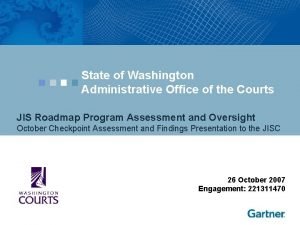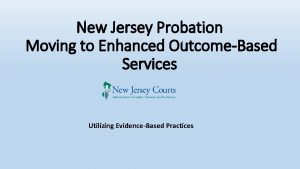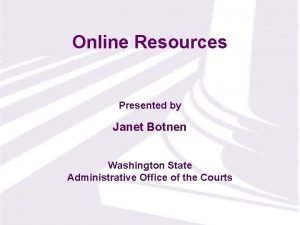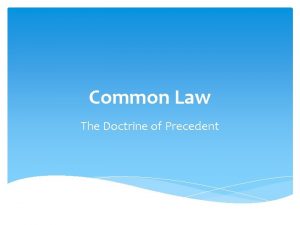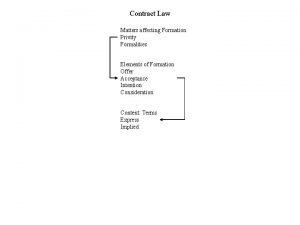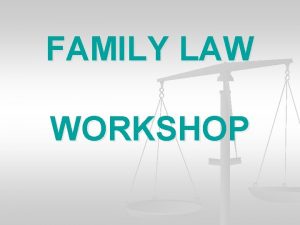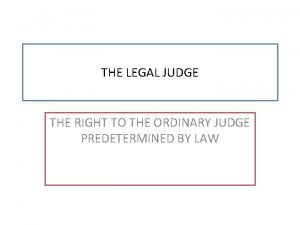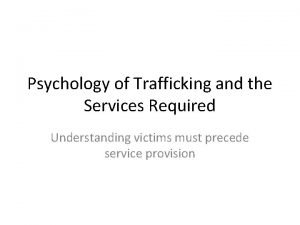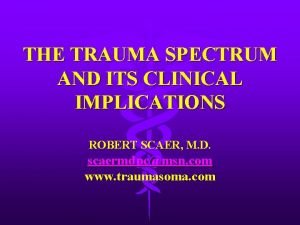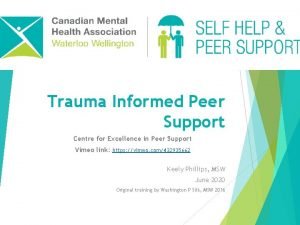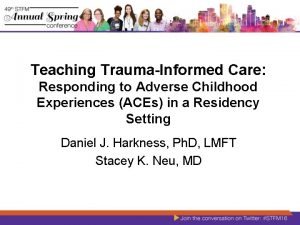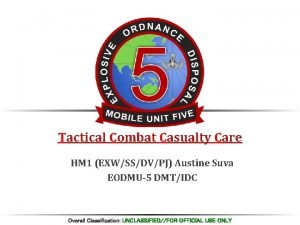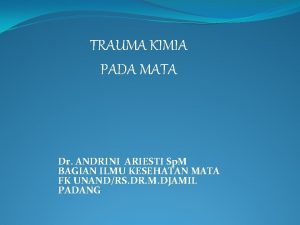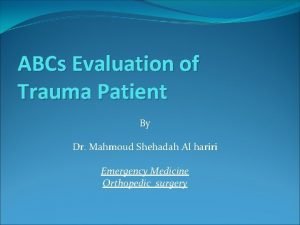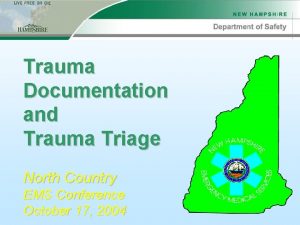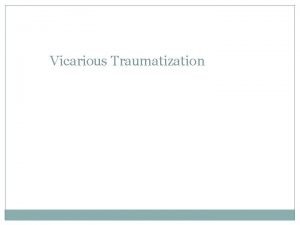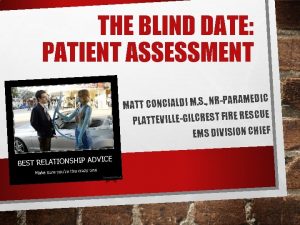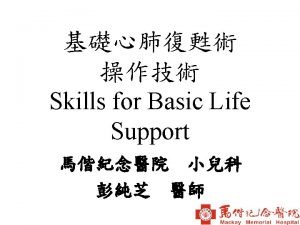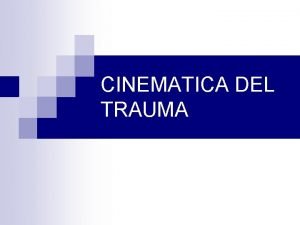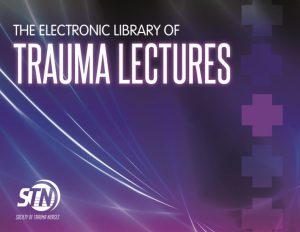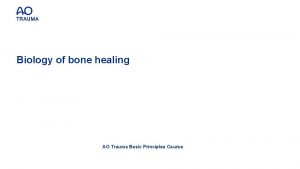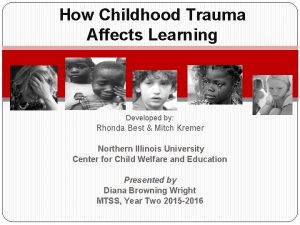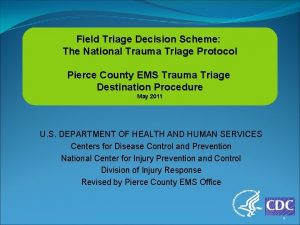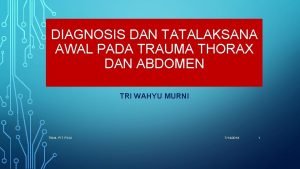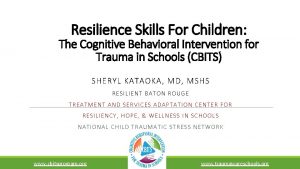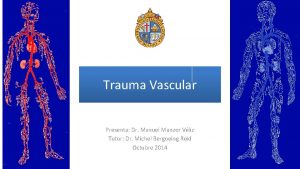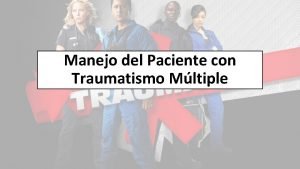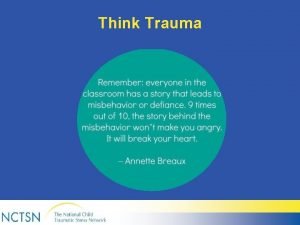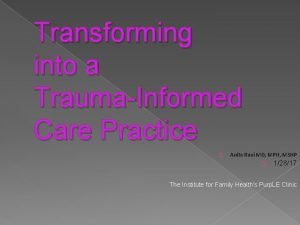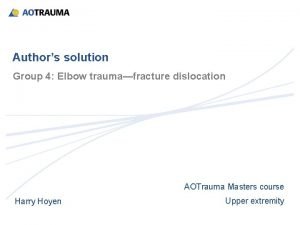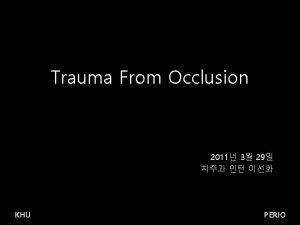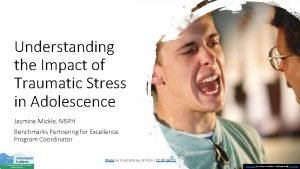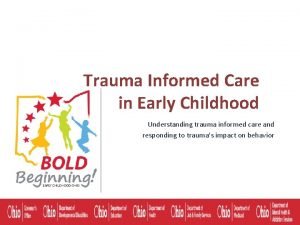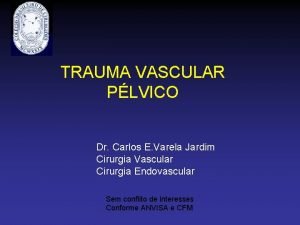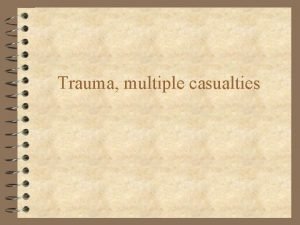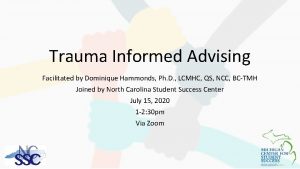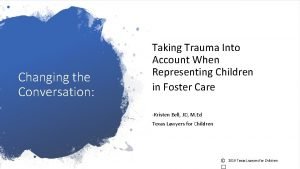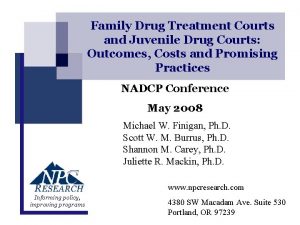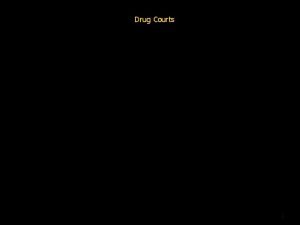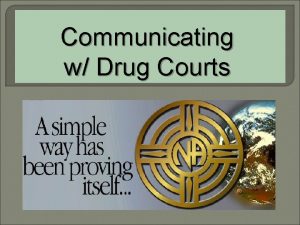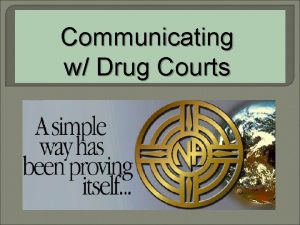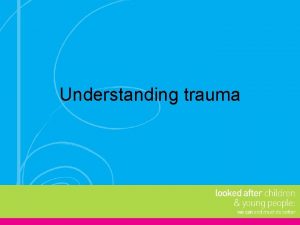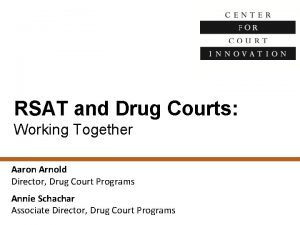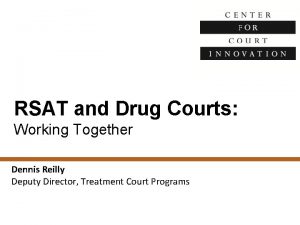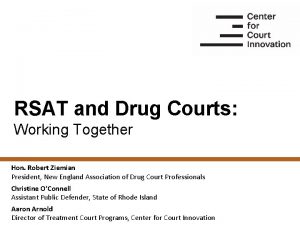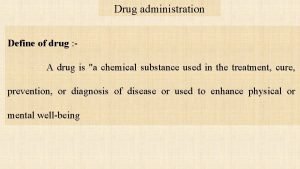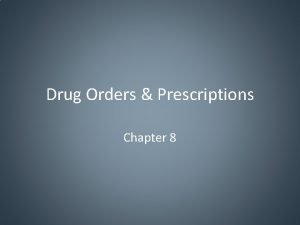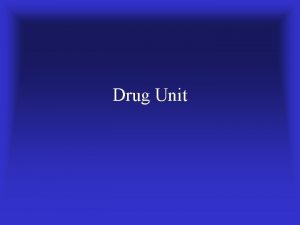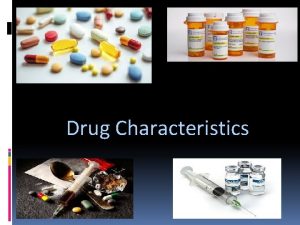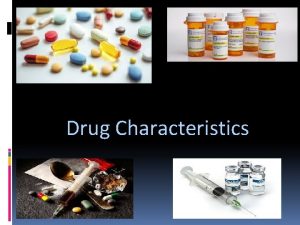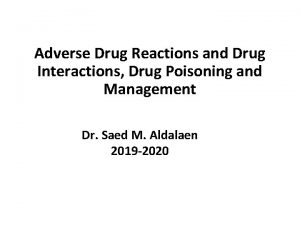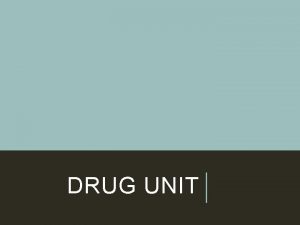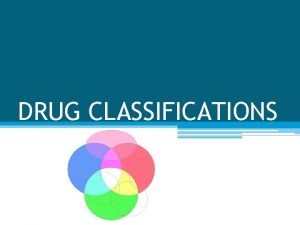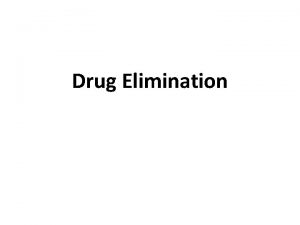Understanding Trauma Working with Trauma in Drug Courts




































































- Slides: 68

Understanding Trauma: Working with Trauma in Drug Courts & Developing a Trauma-Informed Practice of Care & Self-Care May 11, 2017 Wisconsin Statewide Conference 2017 Kathleen West, Dr. PH Consultant, National Drug Court Institute (NDCI) UCLA Dept of Social Welfare USC Dept of Preventive Medicine

“Trauma-informed care” (TIC) is an evidencebased practice that teaches service providers and their organizations about the triggers and vulnerabilities of those affected by traumatic experiences and how to use effective interventions. TIC involves understanding, anticipating, and responding to traumatized people’s expectations and needs by modifying how we and the systems within which we work function to minimize re-traumatization. SAMHSA - adapted

Session Objectives 1. Identify factors that have increased awareness of traumatic experiences in society at large 2. Explain how direct and indirect traumatic exposures affect our psycho-social, biological, and spiritual well-being 3. Identify your own emotional, physical, and behavioral responses to traumatic experiences associated with Drug Court work 4. Understand how these responses affect you, your work with clients, colleagues/work environment, your own relationships, your community, and your worldview 5. Describe some practical tools and evidence based strategies your work setting can implement to minimize re-traumatization of clients and staff 6. Discuss steps each Court team can take to develop an overall practice of trauma-informed care within your Court

Trauma can be induced by experiences that lead to abnormally intense, prolonged stress responses Trauma can be experienced directly (primary) or secondarily – by hearing about it or bearing witness to its effects

Any examples of traumatic experiences in your Drug Courts lately? • Probably many • so WHY haven’t we addressed trauma in the past?

Increased understanding of the role of trauma in many diseases, including SUDs And the need to address trauma to achieve health and wellness “It is difficult to get a man to understand something, when his salary depends on his not understanding it. ” Upton Sinclair

Trauma: A Very Brief History • 1980: DSM-III included PTSD as a diagnosis to introduce “war neurosis” into official psychiatric nomenclature -The stressors leading to PTSD diagnosis were thought to be “generally outside the range of common experiences” • 1992: Judith Herman’s “Trauma and Recovery” moved discussion to that of psychological care (not just medical trauma) • 1998: Felitti, et al’s publication of ACE Study described affect of Adverse Childhood Experiences • 2010 -2016: 946, 000 articles on trauma and mental health with an additional 143, 00 articles specifically on “traumainformed care” with increasing attention to TIC SYSTEMS development

Are we experiencing more trauma?

24 -hour “News” Cycle, + constant social media, = overload, “burnout”, fear, anxiety, increased stress, vicarious trauma Heroin Kills 23 Year-Old Man in Yates Coun Second Overd ty - ose in Four Da ys verdoses o g u r d f o e v a g hit by a w in e b INE HESSEL is R u E o H L T. t A S K n Y B w , o t 6 Down BER 10, 201 M E V O N , M A POSTED 12: 06 kee u a w il M 0 2 ected in Heroin susp eeks w 2 n i s h t a e d Heroin overdoses are becoming all too common. USA TODAY NETWORK, USA TODAY


US Mass Shootings & Fatalities Rising

Opioid Fatal Overdoses Increasing Heroin deaths exceeded gun homicides in 2015 for first time. In 2016, 52, 404 died from opioid overdoses

Trauma increasingly viewed as a “Hidden Epidemic” – may be “endemic” • Unseen, but likely at the root of – Anxiety Disorders – Depression – PTSD – Addictions – OCD, other compulsions, & impulse control disorders – Risk-taking – Suicidality & non-suicidal self-injury – Re-victimization – Attachment and relationship difficulties

Types of Trauma Chronic Trauma Acute Trauma Vicarious Trauma Complex Trauma System Induced Trauma

Trauma-Related Definitions • Acute Trauma: Single, time-limited traumatic event exposure (rape, car accident, etc. ) • Chronic Trauma: Multiple, possibly varied traumatic event exposure (war exposure, ongoing physical abuse, etc. ) • Complex Trauma: Term is used to discuss both exposure to chronic trauma & impact of trauma • System-Induced Trauma: Situations in which organized systems create trauma, including those designed to mitigate trauma (foster care, rape victim interviews, law enforcement and court actions, juvenile detention facilities, etc. ) • Resiliency: A pattern of positive adaptation in the context of past or present adversity CWC/NCTSN, 2008

Complex PTSD • PTS occurs on a spectrum – Partial experiences may occur in certain domains: Eg: only nightmares, but no awake re-experiencing (no flashbacks, etc. ) • Traumatic experiences over time affect individuals differently – One aspect of trauma currently being addressed can activate another area of traumatic experience • Eg: processing adult traumatic events can be complicated by triggering unmanaged childhood traumatic exposures

Secondary Trauma Related Terms: These terms relate to traumatic stress reactions that have biological, psychological, and sometimes physical illness components that are caused by exposure to other people’s traumatic experiences; generally that exposure is through hearing about or seeing evidence of the primary trauma • Compassion fatigue - depletion & deterioration of ability to empathically respond • Secondary traumatic stress - parallel symptoms to PTSD • Vicarious trauma – can have PTSD symptoms, and/or changes in one’s worldview, cognitive scheme, and view of oneself • Burnout – sense of being overburdened, powerless, unable to feel happy, and ultimately unable to continue one’s work

Other Types of Trauma • Group Trauma – Military, first-responders (police, firefighters, emergency personnel, etc. ), gang members • Historical Trauma – Japanese internment camps, First People’s genocide, African American slavery • Mass Trauma – Hurricane Katrina, Flint water supply, Porter Ranch Aliso Canyon, Refugees, War survivors • Interpersonal Trauma – Intimate partner violence, child molest and abuse • Systems Induced Trauma – Usually involves re-victimization

http: //www. cdc. gov/ace/index. htm

Adverse Childhood Experiences (ACE) Study Findings & SUDs Each ACE increased the likelihood for early initiation of drug use 2 to 4 -fold Individuals with 5 or more ACEs were 7 to 10 -fold more likely to be have Substance Use Disorders (SUDs) Effects of ACEs outweigh increased drug access, attitudes towards drugs, and public education campaigns to prevent drug abuse for 4 successive cohorts back to 1900 ACE: a retrospective study of 8, 613 adults interviewed re: original ACE 8 categories: Childhood Abuse (3 items: emotional, physical, sexual), Household Dysfunction (5 items: substance abuse, mental illness/depression/suicidal, battered mother, incarcerated family member, at least 1 biologic parent died before subject 18 yrs)

10 ACES Survey Questions While you were growing up, during your first 18 years of life: 1. Did a parent or other adult in the household often or very often… Swear at you, insult you, put you down, or humiliate you? or Act in a way that made you afraid that you might be physically hurt? Yes /No If yes enter 1 2. Did a parent or other adult in the household often or very often… Push, grab, slap, or throw something at you? or Ever hit you so hard that you had marks or were injured? Yes/ No If yes enter 1 3. Did an adult or person at least 5 years older than you ever… Touch or fondle you or have you touch their body in a sexual way? or Attempt or actually have oral, anal, or vaginal intercourse with you? Yes/ No If yes enter 1 4. Did you often or very often feel that … No one in your family loved you or thought you were important or special? or Your family didn’t look out for each other, feel close to each other, or support each other? Yes/ No If yes enter 1

5. Did you often or very often feel that … You didn’t have enough to eat, had to wear dirty clothes, and had no one to protect you? or Your parents were too drunk or high to take care of you or take you to the doctor if you needed it? Yes /No If yes enter 1 6. Were your parents ever separated or divorced? Yes/ No If yes enter 1 7. Was your mother or stepmother: Often or very often pushed, grabbed, slapped, or had something thrown at her? or Sometimes, often, or very often kicked, bitten, hit with a fist, or hit with something hard? or Ever repeatedly hit at least a few minutes or threatened with a gun or knife? Yes/ No If yes enter 1 8. Did you live with anyone who was a problem drinker or alcoholic or who used street drugs? Yes/ No If yes enter 1 9. Was a household member depressed or mentally ill, or did a household member attempt suicide? Yes /No If yes enter 1 10. Did a household member go to prison? Yes No If yes enter 1 Now add up your “Yes” answers: _______ This is your ACE Score

Vincent Felitti, MD, Director, study, Kaiser Permanente CA www. acesconnection. com

Trauma, Violence, & Substance Abuse • Children & youth are at highest risk for being victims of violence (3 x adult rate) • Substance abuse, aggression, & trauma exposure are highly correlated • Trauma exposure also correlates with: - substance use with high risk behaviors - substance use associated with both perpetration of violence – and victimization - substance use related to severe accidental injury, personal loss, and ensuing trauma Drug Courts with High Risk High Need Population, Have Clients with Trauma

Three components (circuitry) of the CNS Involved in Extreme Stress & Trauma 1 Autonomic Nervous System (in the medulla oblongata - brainstem) coordinates functioning of organs of the body - Sympathetic side: “fight or flight” - Parasympathetic side: “feed or breed” 2 Amygdala – Threat memory system – Threat alarm system 3 Hippocampus and prefrontal cortex (PFC) – Self-control system – Declarative memory storage and recall – HC is very stress-vulnerable part of brain

Autonomic Nervous System

Feelings/Physical Reactions in body originate in brain (ANS) • Parasympathetic: Sympathetic: -saliva production -inhibits saliva -constricts bronchi -dilates bronchi -slowed heart - accelerates heart -stimulates stomach, pancreas, intestines - stimulates urination Heart racing, sweaty palms, dry mouth, heart stopping, faint or dizzy, shortness of breath, knot in stomach, acrid taste in mouth, eyes tearing, ears burning, throat choking, body trembling, face flushing

Sympathetic nervous system • Noradrenaline • Adrenaline involved in fight and flight within the adrenal medulla • Noradrenergic system becomes hyperactive in PTSD: breaks down in blood, urine, & cerebral spinal fluid so total body is , as well as specific chemical target sites in the brain

Brain Centers Affected by Traumatic Stress HIPPOCAMPUS & PREFRONTAL CORTEX Major memory and self-control system AMYGDALA Threat alarm system

Brain Centers Affected by Traumatic Stress When it comes to anxiety, the prefrontal cortex (PFC) and amygdala are working against each other eg: Counting to 10 engages PFC & shuts down Amygdala; Managing stress requires PFC to stay online, so you don’t do things you’ll later regret… Usually “what should I do? ” calls on PFC, but amygdala overrides, causing dissociation, hyper-reactivity, etc. HIPPOCAMPUS & dorso-lateral PREFRONTAL CORTEX Major memory and self-control system AMYGDALA – teaches how & when to be afraid. Cues & reminders so powerfully engage amygdala that PFC can’t work in PTSD case Hippocampus is encoding memory and context & helps information transition into long-term memory -- & is connected to amygdala

Glutamate Neurons in Hippocampus and Prefrontal Cortex Can Die From Stress Capt (ret) William Nash, MD

Traumatic exposures are toxic to our brains • Brain Grey Matter contains most of the brain's neuronal cell bodies. The grey matter includes regions of the brain involved in muscle control, and sensory perception such as seeing and hearing, memory, emotions, speech, decision making, and self-control. • 20% of all oxygen taken in by the body goes to the brain and 95% of that goes specifically into the grey matter. • Trauma exposure in and of itself appears to be sufficient to cause structural brain changes – for example to grey matter - regardless of PTSD development (Ahmed, F. , Spottiswoode, B, Carey, P. , Stein, D: Neuropsychobiology 2012; 66: 174 -184)

Gray matter changes post trauma exposure More than 3 yrs after the 9/11/01 terrorist attacks, whole -brain Voxel-based morphometry shows multiple areas with significantly lower mean gray matter volume in healthy adults who were within 1. 5 miles of the World Trade Center compared to a comparison group, controlling for age, sex, and total gray matter volume. Regions with lower GM in 9/11 group include the amygdala, anterior hippocampus, insula, medial prefrontal cortex, and anterior cingulate.

Stress & Resilience Responses • Pre-stress Stress Post-stress -Alarm dys-regulation -Failure of regulation Genotypes EXTREME STRESS -Conditioned fear EXPOSURES -Depression Neural subjective responses Prior Stress Exposure & Preparation -Post traumatic growth - Accommodation - PTSD symptoms

Variability in Experience of Trauma • Traumatic experience is filtered through cognitive and emotional processes before it can be appraised as an extreme threat • Individual differences (in many domains: genetics, experience, social context), means that different people have different thresholds for what is experienced as traumatic • Risk and Protective Factors lead to vulnerabilities and protection to developing clinical symptoms after exposure to extremely stressful situations • Events such as rape, torture, genocide, and severe war zone stress are experienced as and recognized as traumatic events nearly universally 35 National Center on PTSD

Some Common Short & Long Term Reactions to Traumatic Experiences • • Helpless, hopeless, uncreative Angry and cynical Inability to empathize or sympathize Sense of threat, fear, persecution; can develop into belief that world is unsafe Dissociation Hyper-vigilance Inability to deal with complexity, & minimizing Chronic fatigue, pain, ill-health

Factors in Recovery & Resiliency or Symptom Development • Ability to Bounce Back • Pre-quel – Pre-existing Life Experiences • Cumulative issues: intensity, frequency, duration (chronicity/acuity, respite, etc) • Coping skills: acquired, learned, modeled, internalized • Ability, access, and willingness to seek mental/behavioral health help (ignorance, stigma, fear, shame)

Individuals with PTSD consistently have lower levels of neuropeptide Y – so the recovery from the adrenaline (among other things) is much slower to shut down – compromising capacity for resilience

Levels of Adrenaline Levels of Neuropeptide Y

Now that you Understand the Role of Traumatic Exposures • • • In individuals (primary, secondary & tertiary effects) In families (inter-generationally) In groups In our workplaces In societies (tertiary) • Implications for how we interact with cases clients, patients, and how we manage program settings to maximize the sense of safety and minimize trauma reminders • Our clients are directly affected by their trauma, influencing their ability to cope • Drug Court staff are also affected…

Some Good News: • Our brains can heal and grow throughout our lives; neuroplasticity is the capacity of the brain to change by learning • Changes associated with learning occur mostly at the level of neuronal connections • New connections can form and the internal structure of existing synapses can change • Social systems can change via the learning of their individual members • At a systems level, Drug Courts can develop trauma-informed practices and a TIC culture

ALL Cultures - & Subcultures – Mediate Traumatic Exposures & Response

US cultural mediation of substance abuse, drug addiction, criminal charges, and trauma: Drug Treatment Courts - YOU!

Trauma-informed approach to practice in Drug Courts (and team organizations) Involves 3 elements: 1) Realize the prevalence of trauma 2) Recognize how trauma affects all individuals involved with the Drug Court - including each member of the Team 3) Respond by putting knowledge into practice to create a culture of safety and minimize re -traumatization and trauma triggers

The Social Ecology of Trauma “Social Bonds and Posttraumatic Stress Disorder” by Charuvastra & Cloitre, 2008 --Human-caused events create greater risk for PTSD than naturally occurring events --Social support perceptions Before and After traumatic event(s) are important factor in risk of developing PTSD & other anxiety/depressive disorders ---- Both the risk of experiencing debilitating trauma AND successful recovery and interpretation of such events are dependent on positive social networks (families and institutions including courts, schools, faith-based settings, etc) Social support & trust is a very effective emotion regulator – especially with regard to fear and safety

To Create Trauma Informed Care in Drug Courts, Consider Two Levels: • Organizational Response – Responsibility to clients – Responsibility to co-workers • Personal /Professional Response – Responsibility for self – Responsibility for relationships with intimate connections, family, friends, and community

Trauma-Informed Care (TIC) is recognized as a Best Practice • Trauma Informed Care is an approach to Court conduct and treatment “that involves understanding, recognizing, and responding to the effects of all types of trauma. • TIC emphasizes physical, psychological and emotional safety for both consumers and providers, and helps survivors rebuild a sense of control and empowerment. ” • TIC asks not “what’s wrong with you? ” but “what happened to you? ”

TIC • Trauma Informed Care also aims to reestablish a sense of empowerment that the client –and provider- has lost through trauma - and institutional, collective trauma • This approach and manner of treatment recognizes “the survivor’s need to be respected, informed, connected, and hopeful (regarding their own recovery). ” – (SAMHSA, 2015)

Ten Principles of Trauma Informed Services 1. Recognize impact of violence and victimization on coping skills 2. Establish recovery from trauma and management of trauma as an element in case plans 3. Employ empowerment model - 4. Maximize choice and support decision-making skills 5. Base programming and interactions on relational collaboration

Ten Principles of Trauma Informed Services continued… 6. Structure environment designed to ensure safety, respect and acceptance 7. Highlight strengths and resiliency 8. Minimize possibility of re-traumatization 9. Become culturally competent and understand the client from the context of their life experience 10. Solicit consumers’ input and feedback in design and evaluating services – Listen!

Creating Cultures of TIC • Creating Cultures of Trauma-Informed Care: An Agency Self-Assessment and Planning Protocol • For Both Consumers and Staff • 5 guiding Principles of Trauma-informed practice: – Safety – Trustworthiness – Choice – Collaboration – Empowerment

Some TIC Initial Drug Court Questions for your Cases • EXAMPLES OF SAFETY, CHOICE, TRUST-INDUCING, EMPOWERING & COLLABORATIVE QUESTIONS – What information would be helpful for us to know about what happened to you? your child? your family? – Where/when would you like us to call you? (& THEN act on this throughout your Team) – How would you like to be addressed? – Of the services I’ve described, which seem to match your present concerns and needs? Prioritize these along with Drug Court services. – From your experience, what responses from others appear to work best when you feel overwhelmed by your emotions?

Drug Court Team Self-Care Rationale We sometimes carry the expectation that we will give to others before attending to our own needs This is ultimately self-defeating Drug Court Teams will function optimally overall by being intentional and proactive about finding time to create a culture of caring for each other in the workplace and promoting individual selfcare

Prepare to Take Care Self Assess for Stress. Periodically (at least annually) assess and realign goals, skills, work, and play passions. Notice disparities and take steps to correct your course! Evaluate: check a typical week’s schedule, prioritize tasks & reduce/eliminate nonessential tasks! Do quarterly “Check ins” to increase likelihood of early recognition of being out of balance, so support & remedies can be mobilized!

10 things to do each day to develop resilience and ability to work with care, energy, and compassion 1. Get enough sleep (7 -8 hours for REM) 2. Get enough good food to eat 3. Do some light exercise 4. Vary the work that you do 5. Do something pleasurable 6. Focus on what you did well 7. Learn from a mistake 8. Share a joke 9. Relax, pray, or meditate www. proqol. org 10. Support a colleague

Characteristics of Resilient People • View change or stress as a • challenge/opportunity • Commitment • • Recognition of limits to control • • Engaging the support of • others • • Personal or collective goals • Self-efficacy • • Past successes in coping well with stress • • Faith Realistic sense of control/having choices Sense of humor Action oriented approach Patience Tolerance of negative affect Adaptability to change Optimism Connor & Davidson, 2003 – table 7

EVIDENCE-BASED Cognitive-Behavioral INTERVENTIONS to reduce anxiety, increase coping, & build resilience • Psychoeducation: for individuals & family/ support system • Cognitive processing skills; eg: problem solving • Personal empowerment training (eg: goal setting) • Emotional Regulation Skills (eg: use of “feeling thermometer”) • Communication (assertive “I” based) • Trauma narrative and/or Family Timeline (meaning development) • Trauma and Loss Reminder Management E Examples: FOCUS Project at UCLA

Emotional Regulation Skills UCLA FOCUS Project

Stress Continuum: Four Stress Zones READY REACTING • Mild and transient distress or • Effective loss of functioning function • Health and • Very common well being • Self • The goal of correcting resilience • Persistence efforts may lead to stress injury • Adaptive coping INJURED ILL • More severe • Diagnosable and persistent mental distress or loss disorders of function • DSM-V • Less common criteria • Heals with attention or care • May follow unhealed stress injury • Persistence may lead to illness • More Rare • Needs treatment Care Continuum: Self care , “Buddy Care”, Professional Intervention

Consider establishing explicit guidance to limit traumatogenic communication • What is traumatogenic communication? - Verbal Sharing that provides images, details, descriptions of traumatic event coupled with one’s response - Communication that creates an unnecessary trauma exposure to another person • Appropriate setting for this is in professional therapeutic relationship • Communication without gorey details of trauma can be equally effective • What kind of guidelines do you already have in place for this? • How do you manage this now? Cosic, K. , et al. ,

Variability in Experience of Trauma • Traumatic experience is filtered through cognitive and emotional processes before it can be appraised as an extreme threat • Individual differences (in many domains: genetics, experience, social context), means that different people have different thresholds for what is experienced as traumatic • Risk and Protective Factors lead to vulnerabilities and protection to developing clinical symptoms after exposure to extremely stressful situations • Events such as rape, torture, genocide, and severe war zone stress are experienced as and recognized as traumatic events nearly universally 61 National Center on PTSD

EG: Grounding: mind-body connection work • Grounding is the act of connecting more deeply and completely to the body, strengthening the feeling of being inside the body and connected to the ground or earth. – Many grounding exercises help deepen connection to anything that is supporting the weight of the body. – Other grounding exercises help deepen connection to our 5 senses, using them to connect us with our body in general. • When grounding by connecting to the ground or objects that support our body, we may tune into the following kinds of feelings in the body: 1. What it feels like to be physically supported 2. The feeling of having a definite physical location 3. The feeling of the solidity and stability of the physical objects that are supporting our body

SWITCHING ON & OFF Empathy helps you do this work. It is essential to take good care of your feelings and thoughts by monitoring how you use them. Turning off feelings when you go on duty, and on again when you go off duty can be an effective coping strategy. Protection is offered by switching off and support can be received when resting and switched on. www. proqol. org

SWITCHING ON & OFF 1. Switching is a conscious process. Talk to yourself as you switch. 2. Use images that make you feel safe and protected (switch off) amd connected and cared for (switch on) to help you switch. 3. Find rituals that help you switch as you start and stop work. 4. Breathe slowly and deeply to calm yourself when starting a difficult, tough job. www. proqol. org

SWITCHING ON & OFF -- After you switch back “on”, - breathe deeply and attend to yourself, - focus on what you did well, - support a colleague, - relax, meditate, pray - do something pleasurable - notice any upsetting thoughts and stay current by processing them with a supervisor

Drug Court Team Group Exercise • Use Creating TIC Drug Court Culture worksheets in small groups to discuss ways your organization can enhance team members’ – Safety – Choice – Collaboration – Empowerment – Trust And ultimately hopefulness, and resilience of each staff member and Drug Court overall!

Selected Bibliography 1. Anda, R. F. , Felitti, V. J. , Bremner, J. D. et al. (2006) The enduring effects of abuse and related adverse experiences in childhood: A convergence of evidence from neurobiology and epidemiology. Eur Arch Psychiatry Clin Neurosci pp: 256: 174. 2. Bloom, S. L. , (2006) Neither Liberty Nor Safety: The Impact of Fear on Individuals, Institutions, and Societies, Part IV. Psychotherapy and Politics International. 4(1): 4 -23 3. Fallot, R. D. & Harris, M. (2009) Creating cultures of trauma-informed care (CCTIC): A self-assessment and planning protocol. Washington DC: Community Connections. 4. Ganzel, B. L. , et al. (2008) Resilience after 9/11: Multimodal neuroimaging evidence for stress-related change in the healthy adult brain. Neuro. Image. Vol 40, Issue 2, April. , pp 788 -795. 5. Harrison, R. L. , & Westwood, M. J. , (2009) Preventing vicarious traumatization of mental health therapists: Identifying protective practices. Psychotherapy: Theory, Research, Practice, Training, Vol 46(2), June. , pp 203 -219. 6. Ko, S. J. , et. al. (2008) Creating Trauma-Informed Systems: Child Welfare, Education, First Responders, Health Care, and Juvenile Justice. Professional Psychology: Research & Practice. Vol 39, No 4. 396 -404. 7. Kresmir, C. , et. al. (2012) Emotionally based strategic communications and societal stress-related disorders. Cyberpsychology, behavior, and social networking. Vol 15(11) Nov, , pp 597 -603. 8. Substance Abuse and Mental Health Services Administration. (2014) Trauma Informed Care in Behavioral Health Services. Treatment Improvement Protocol (TIP) Series 57. HHS Publication No. (SMA) 14 -4816. Rockville, MD: SAMHSA. 9. Yeager, K. Cutler, D, Svendsen, D. , & Sills, G. (EDs ) (2013) Modern Community Mental Health: An Interdisciplinary Approach. “Trauma-Informed Care”, Chapter 5, pp 62 -83. Huckshorn, K. & Le. Bel, J. Oxford University Press, New York.

Resources • http: //www. joyfulheartfoundation. org/about-us/welcome • www. proqol. org • Resilience after 9/11: Multimodal neuroimaging evidence for stressrelated change in the healthy adult brain. Neuro. Image. Vol 40, Issue 2, April 2008, pp 788 -795. • Emotionally based strategic communications and societal stressrelated disorders. Cyberpsychology, behavior, and social networking. Vol 15(11) Nov 2012. , pp 597 -603. • Preventing vicarious traumatization of mental health therapists: Identifying protective practices. Psychotherapy: Theory, Research, Practice, Training, Vol 46(2), June 2009, pp 203 -219. Questions? kathleenmwest 3@gmail. com
 Deliberate adulteration definition
Deliberate adulteration definition Smart vs hard working
Smart vs hard working Pembentukan logam
Pembentukan logam Hot working of metals
Hot working of metals Hot working and cold working difference
Hot working and cold working difference Differentiate between hot working and cold working
Differentiate between hot working and cold working Washington administrative office of the courts
Washington administrative office of the courts Hierarchy of uk courts
Hierarchy of uk courts Court meta 90mspanglervariety
Court meta 90mspanglervariety The inferior courts chapter 18 section 2
The inferior courts chapter 18 section 2 Romeo and juliet poem summary
Romeo and juliet poem summary New jersey courts
New jersey courts Chapter 18 section 4 the special courts worksheet answers
Chapter 18 section 4 the special courts worksheet answers Inside courts wa
Inside courts wa Court hierarchy
Court hierarchy Uk courts hierarchy
Uk courts hierarchy State courts us
State courts us Judicial restraint clipart
Judicial restraint clipart Squash court wolverhampton
Squash court wolverhampton When will the courts imply terms into a contract
When will the courts imply terms into a contract Tteap
Tteap 4 levels of state courts
4 levels of state courts [email protected]
[email protected] Levels of court uk
Levels of court uk Jurisdiction of supreme court
Jurisdiction of supreme court 3 types of courts in india
3 types of courts in india The indolent judge
The indolent judge Specialisation court hierarchy
Specialisation court hierarchy Dolore emicostato destro
Dolore emicostato destro Trauma bonded
Trauma bonded Trauma spectrum
Trauma spectrum Trauma informed peer support
Trauma informed peer support Pillars of trauma informed care
Pillars of trauma informed care 9 line medevac card
9 line medevac card Trauma kimia mata
Trauma kimia mata Revised trauma score
Revised trauma score Helene dellucci trauma
Helene dellucci trauma Miemss trauma decision tree
Miemss trauma decision tree Vicarious traumatization definition
Vicarious traumatization definition Uccs veterans health and trauma clinic
Uccs veterans health and trauma clinic Dcap btls
Dcap btls Flail chest adalah
Flail chest adalah Ticls
Ticls Cinematica
Cinematica Trauma triad of death
Trauma triad of death Ao trauma
Ao trauma Childhood trauma discussion questions
Childhood trauma discussion questions Field triage decision scheme steps
Field triage decision scheme steps Interceptive orthodontics
Interceptive orthodontics Contusion of thorax
Contusion of thorax Cbits feeling thermometer
Cbits feeling thermometer Triple trauma paradigm
Triple trauma paradigm Trauma vascular
Trauma vascular Escala abreviada de lesiones
Escala abreviada de lesiones Think trauma
Think trauma Anita ravi md
Anita ravi md Head trauma classification
Head trauma classification Trauma from occlusion treatment
Trauma from occlusion treatment Trauma response
Trauma response Trauma latin declension
Trauma latin declension Facial trauma
Facial trauma 4 r's trauma informed care
4 r's trauma informed care Iatp 5 narrative model
Iatp 5 narrative model Trauma vascular
Trauma vascular Pulmonary trauma
Pulmonary trauma What is the definition of multisystem trauma?
What is the definition of multisystem trauma? Trauma informed advising
Trauma informed advising Conversation change how think trauma
Conversation change how think trauma Holiday segar anak
Holiday segar anak






